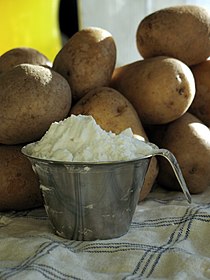Potato starch
Potato starch (including potato flour ) is made from potatoes extracted starch .
Manufacturing
The cells of the plant tuber contain the starch grain ( leucoplast ). In order to extract the starch, the potatoes are first grated so that the starch granules emerge from the destroyed cells. The starch is then washed out and dried to powder.
Potato pulp is a by-product of the extraction of potato starch, or after squeezing the water , pressed potato pulp , which is mainly used as feed for dairy cattle and beef cattle.
Composition and properties
Potato starch contains typical large spherical-oval starch grains, their size is between 5 and 100 μm. It consists mainly of the starches amylose and amylopectin in a ratio of about 1: 4 - 1: 5; in addition, there are small amounts of protein and fat. Due to the high starch content, the flour has a clear white color and the cooked starch has a neutral taste, good clarity, high viscosity, long texture and minimal tendency to foam or yellow color of the solution.
Potato starch contains approximately 800 ppm of phosphate bound to starch; this phosphate increases the viscosity and gives the solution a slightly anionic character, a low gelatinization temperature (approx. 62.5 ° C) and high swellability.
use
Potato starch is used as cornstarch in cooking and baking. In Germany it is therefore generally available as a baking ingredient, often referred to as potato flour .
Potato flour is used as a lubricant in the Carrom and Jakkolo games. But the potato is also made into a bioplastic bag. In addition, potato starch - like starch from other renewable raw materials - is used as an adhesive , e.g. B. in the manufacture of corrugated cardboard . Also Pelikanol made from potato starch.
Web links
- Memorandum on potato starch, International Starch Institute at starch.dk
- Gelatinization of potato starch Video, YouTube (Eng.)
- Recipes for potato starch on Recipes.wikia
Individual evidence
- ↑ Dagmar Wiechoczek: The structure of the starch molecules. In: Prof. Blum's educational server for chemistry. January 23, 2013, accessed October 17, 2019 .
- ↑ Starch Gelatinization at Different Temperatures as Measured by Enzymic Digestion Method . In: Agricultural and Biological Chemistry . 1983, Vol. 47, No. 11. pp. 2421-2425.
